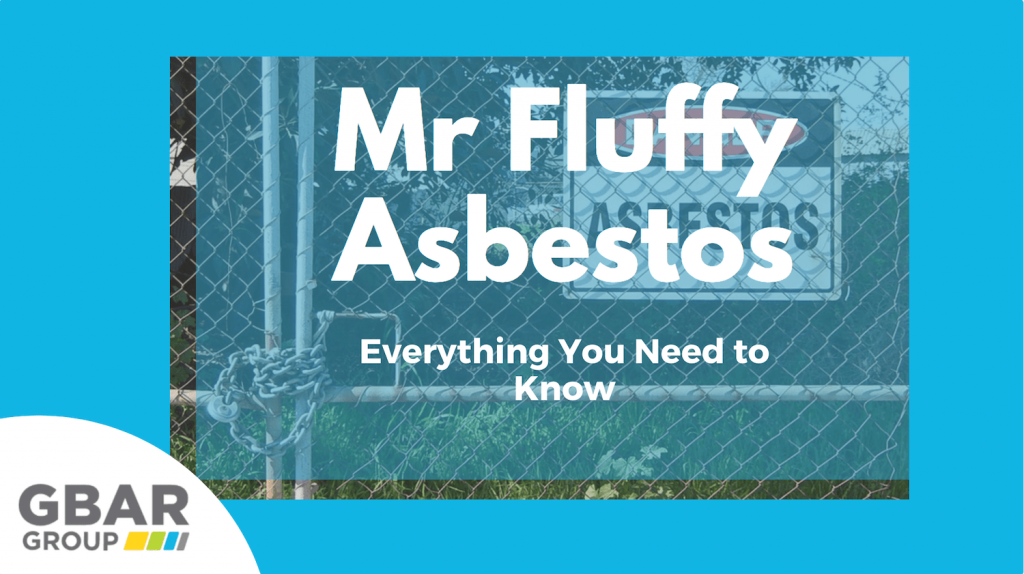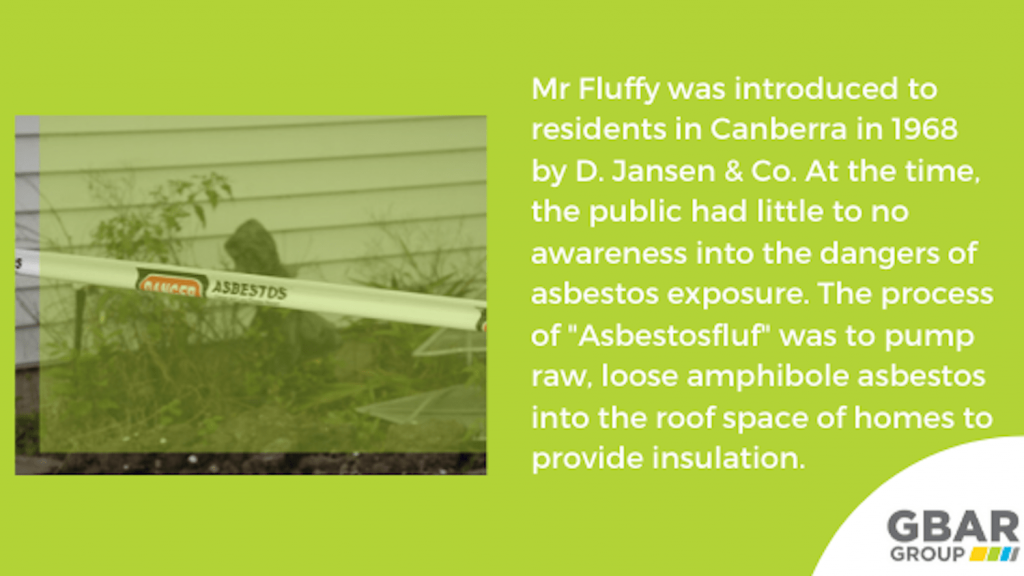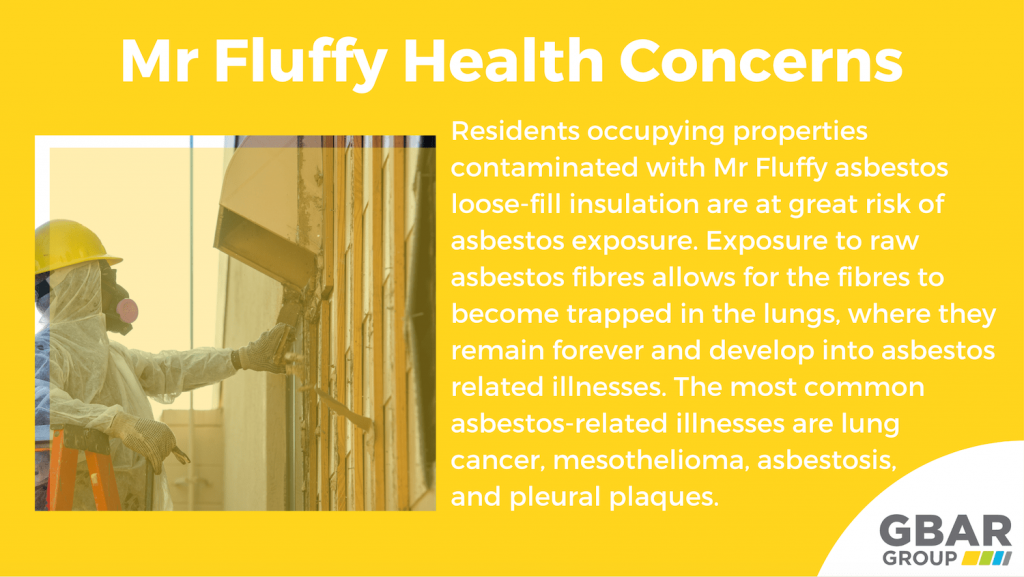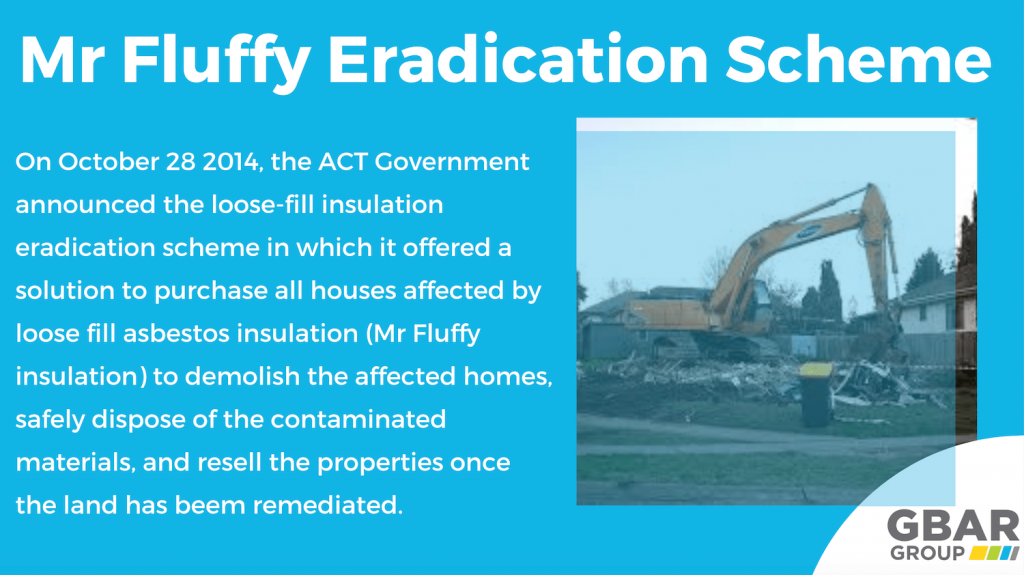
Mr Fluffy is the name used for a type of insulation that was heavily used in Australia in the 1960s and 1970s.
Named for its fluffy texture and appearance, the insulation was made from raw asbestos fibres and was installed as a roofing insulation material. The name Mr Fluffy now commonly refers to a widespread contamination incident that occurred in the suburbs of Canberra, the capital city of Australia.
During the 1960s and 1970s, two major companies imported and installed fibrous, loose-fill amphibole asbestos as an insulation product. The process involved blowing the loose-fill asbestos product into the roof spaces of homes and buildings. The companies are also thought to have sold the sacks of pure asbestos fibre directly to homeowners to insulate their own homes.
Mr Fluffy Asbestos Insulation
Asbestos was pumped into the roofing spaces of homes and marketed by Mr Fluffy as the perfect insulating material. Advertised as “asbestosfluf”, the companies selling and installing the insulation boasted that the material retains effectiveness forever. The insulation was a cost-effective and popular insulation choice for homeowners during the 1960s and 1970s.

During the height of Mr Fluffy, there was little to no knowledge by the public about the dangers of exposure to asbestos. The insulation was primarily made with amosite, but traces of crocidolite have also been found in the products since. While most asbestos-containing materials and products used were bonded, Mr Fluffy insulation was not held together with any bonding agent and could easily release the raw and deadly fibres into the air.
The problem with Mr Fluffy insulation is that the asbestos texture allowed it to migrate into corners of the roofs, sit on top of cabling, pipes, into the cracks and settle. The tiny asbestos fibres were able to contaminate the entire house after being pumped into the ceilings.
Once it became clear that asbestos exposure was directly linked to lung cancer, mesothelioma, and other serious health concerns, the federal government became concerned with the companies selling Mr Fluffy and eventually, all operation was shut down. For many residents, it was too little too late, and they were left with asbestos-contaminated properties.

Mr Fluffy Asbestos Canberra Legacy
In response to the growing concern about the health hazards of Mr Fluffy’s product, a government audit identified most of the homes in the ACT containing Mr Fluffy insulation. A clean-up program was conducted by the government between 1989 and 1993 and was thought to have managed the problem.
However, 25 years later, it became clear that the clean-up act was not nearly as effective as originally believed. Many homeowners were living amongst hazardous asbestos fibres for decades without realising they were at risk of exposure.
By 2014, asbestos had been banned for over 15 years in Australia. In response to the growing health concerns of the affected community, a home demolition scheme was established. It had been discovered and confirmed that Mr Fluffy homes in Canberra were unsafe for habitation considering the asbestos-related health risks that were posed to homeowners and their families.
The scheme involved the purchases of houses contaminated by Mr Fluffy asbestos insulation in the 1960s and 1970s, the demolition of these houses, and the sale of the land for redevelopment. Today, almost all Mr Fluffy homes have been demolished and face redevelopment or resale – as of December 2019, approximately 45 Mr Fluffy houses remain in Canberra.

The Mr Fluffy saga has been playing out in Canberra for more than a decade, and it is now expanding to New South Whales and surrounding areas.
Mr Fluffy Asbestos Register
The ACT Government is required under the Home Building Act 1989 and the Dangerous Substances Act 2004 to maintain a register of residential properties that contain loose-fill asbestos insulation. The register, known as the Affected Residential Premises Register, was created to monitor and manage the houses that had been installed with Mr Fluffy and face contamination.
With many of the affected Mr Fluffy homes now demolished and new homes built, the affected premises register was publicly published in 2015 with addresses. This was a decision made to enable members of the community, property owners, tradespeople and care workers to know whether they will be working on, visiting, or in the vicinity of an asbestos-contaminated property.
The Asbestos Response Taskforce is responsible for the management and maintaining of the register. The Asbestos Response Taskforce also works closely with industry partners to make Mr Fluffy contaminated properties safe and secure. Established in 2014, the task force was created to coordinate the loose-fill asbestos insulation eradication scheme.
The vast majority of Mr Fluffy affected homes have been demolished. Remediated blocks are becoming increasingly available for purchase by original homeowners and the general public, and new homes are appearing on the blocks to help reinvigorate affected neighbourhoods.
What Does Mr Fluffy Look Like?
If you’re reading this, you’re likely wondering what loose-fill asbestos looks like and how to identify Mr Fluffy products.

Asbestos insulation usually looks like a grey or white fluffy loose material, with a texture like candy floss. Because it is a loose material made from raw asbestos, the tiny fibres can easily be disturbed, and the risk of asbestos exposure is very high. While asbestos does have a very distinct texture and appearance, it is not always easy to identify loose-fill insulation.
The only way to confirm the presence of Mr Fluffy or asbestos insulation is to have it properly sampled and tested by an accredited specialist. Because of the friable nature of loose-fill asbestos, we do not recommend homeowners take the samples themselves or risk disturbing the materials.
If you do suspect your home is contaminated with asbestos fibres, the safest approach is engaging with a professional to obtain a sample, and it have it safely removed. Asbestos specialists like GBAR Group are rigorously trained, accredited and experienced in the safe handling of asbestos materials in Brisbane, Gold Coast, Wollongong, and Sydney. In order to keep your family and your home safe from asbestos, don’t run the risk – call the professionals.






